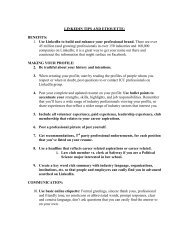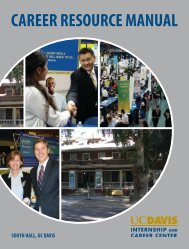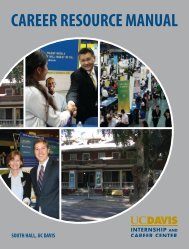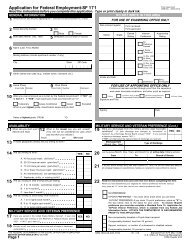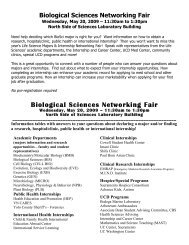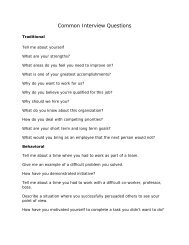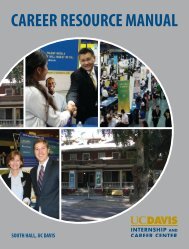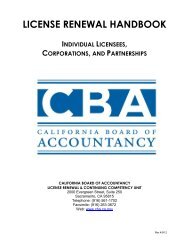career resource manual - UC Davis / Internship and Career Center
career resource manual - UC Davis / Internship and Career Center
career resource manual - UC Davis / Internship and Career Center
Create successful ePaper yourself
Turn your PDF publications into a flip-book with our unique Google optimized e-Paper software.
ReferencesYou will need to bring contact information for 3-5 employmentreferences to your interview. See page 41 forinstructions.Types of Interviews• Screening. This interview usually lasts 30-45 minutes<strong>and</strong> can take place in person or on the phone. It is usedto determine whether the company will invite you tocontinue in the selection process.• Video screening. One-way process where company asksyou to video record you answering questions that yousend to them to screen.• On-site interview. This interview is conducted at acompany facility. If travel is involved, the company mayoffer to pay for your expenses; do not assume this is thecase. Keep receipts <strong>and</strong> carefully follow the guidelinesprovided by the company.• Interview over a meal. This interview is not a social function,it is part of the formal process. Manners count! Noalcohol—ever!• Phone or Skype interview. Make sure you are in a quietlocation, able to focus on the call <strong>and</strong> speak clearly. Haveyour resume, job description, references <strong>and</strong> notes bythe phone. If using a cell phone, make sure it is charged<strong>and</strong> you are in a location where you have good reception.Have a backup plan in case of a dropped call.The interview may also vary in size:• One-on-one interview. One interviewer <strong>and</strong> one inter vieweeis the most common experience. You may have individualinterviews with several members of an organization.• Panel interview. You will be interviewed by a committee,usually between 2-6 people. When you enter the room,shake each interviewers’ h<strong>and</strong> while introducing yourself.It is important to make eye contact with all interviewers.At the end, shake their h<strong>and</strong>s again while thanking them.• Group interview. You will be interviewed simultaneouslywith others. The interviewers will take turns asking questionswhile the other group members observe. Show yourlistening skills by paying attention to what others say <strong>and</strong>try not to repeat their responses. Also be prepared forgroup projects. If your group is assigned a project, use thisopportunity to show your leadership skills by keeping thegroup on track <strong>and</strong> completing the project.• Group Panel. You <strong>and</strong> other interviewees are interviewedby a panel. Participate using the same skills as thoseneeded for a group interview.Other PossibilitiesSome employers are using methods other than (or in additionto) a st<strong>and</strong>ard interview in making hiring decisions.You may be asked to:• submit or evaluate a writing sample• make a presentation to the interview committee (oftenusing electronic media)• take a personality assessment to evaluate potential fit• engage in an active simulation or assessment todemonstrate problem-solving capabilities• communicate with employers via phone, Skype, etc.Day of the InterviewIt is likely you will be nervous before your interview.Here are some tips:• Personal hygiene. Shower <strong>and</strong> be well groomed.• Leave time for mishaps. Traffic, road construction, flattire—leave time in the event that something happens.• Eat prior to the interview.• To reduce sweaty palms, keep a tissue in your pocketto wipe your h<strong>and</strong>s before shaking h<strong>and</strong>s.• Be courteous to everyone at the interview location. Youdon’t know who will be interviewing you, so be polite <strong>and</strong>pleasant to everyone. If you are rude to anyone, that informationwill, more than likely, get back to the interviewer.• Arrive early. Arrive at the interview site approximately15 minutes before your interview. Do not be late! If youknow you will be late, call <strong>and</strong> let the interviewer know.The Interview ProcessThe Beginning• Casual conversation. The interview begins with lightconversation meant to put you at ease. Use this time tobuild rapport.The Middle• Down to business. The actual interview begins when theinterviewer describes the position <strong>and</strong> organization. Listenfor any recent changes <strong>and</strong> how the interviewer refers tothe position.• Employer will ask questions about skills, education, training<strong>and</strong> work history. Many st<strong>and</strong>ard or behavioral-based interviewquestions will be asked. See pages 47 <strong>and</strong> 48.• Be selective about the experiences you present. Alwaysemphasize the positive, but NEVER exaggerate or falsifyinformation.• Show confidence in your responses even if they ask abouta skill or experience you don’t possess (example: “I havenot worked with that particular software package buthave worked with similar packages such as _____ <strong>and</strong> feelconfident I can learn this program in minimal time”).• When asked about your weaknesses, do not reveal a majorflaw <strong>and</strong> be cautious about revealing a personal problem.Talk about an area you would like to improve <strong>and</strong> mentionthe steps you’ve taken to improve it as well as the results.• Be truthful about your willingness to travel or relocate.The End• The end of the interview usually includes the interviewerasking if YOU have any questions. The interviewer mayalso provide you with details of the next steps in the selectionprocess. If not, this is a great question for you to ask.(“Can you tell me what your next steps are in selectingsomeone for this position?”).Interviewing for Employmenticc.ucdavis.edu 45



